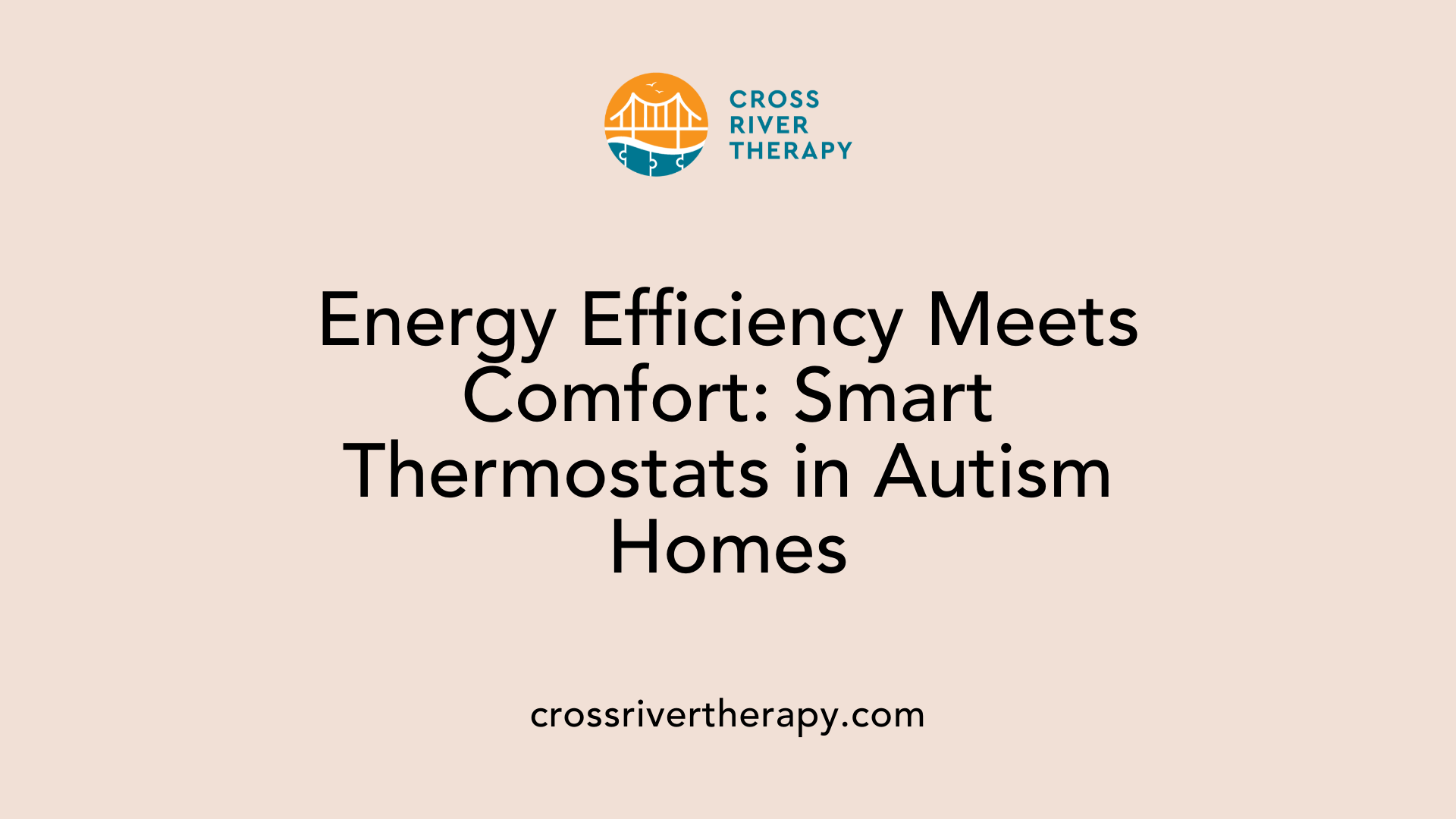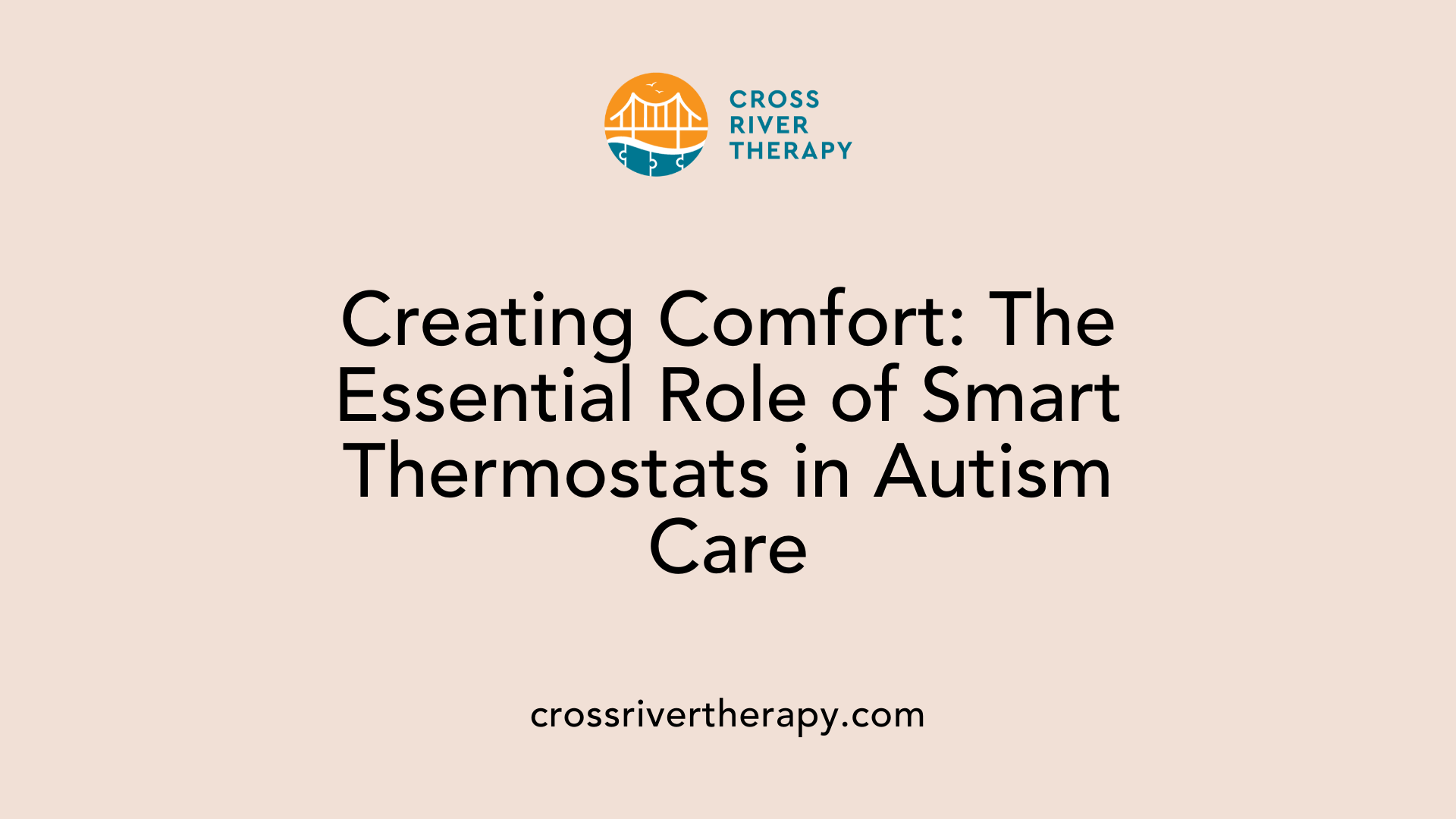Introduction to Smart Thermostats and Autism
With the rise of smart home technology, smart thermostats have emerged as a pivotal tool in enhancing comfort for individuals with autism. These advanced devices offer precise control over home temperatures, ensuring an environment that accommodates the unique sensory needs of those on the autism spectrum. By maintaining consistent temperature levels, smart thermostats play a significant role in reducing anxiety and promoting emotional stability. This article explores the various dimensions of smart thermostat technology, emphasizing its importance in creating autism-friendly environments where comfort and energy efficiency go hand in hand.
Understanding the Benefits for Autism

What are the benefits of smart thermostats for individuals with autism?
Smart thermostats provide critical advantages for individuals with autism, especially in managing the home environment to suit their sensory needs. By allowing precise control over indoor temperatures, they help maintain a stable atmosphere, which is vital for individuals sensitive to temperature fluctuations.
These devices also offer remote accessibility. Caregivers can adjust settings via smartphone apps, ensuring the home remains comfortable, whether individuals are present or not. Smart thermostats learn user preferences and routines, automatically adjusting temperatures to align with their schedules.
Advantages of smart thermostats for autism
- Enhanced Monitoring: Alerts for sudden temperature changes can help caregivers manage indoor comfort effectively.
- Energy Efficiency: These systems can reduce energy consumption by 10-15%, providing financial relief for families.
- Routine Maintenance: Customizable schedules minimize anxiety by creating a predictable environment, which is reassuring for many individuals with autism.
Overall, the integration of smart thermostats fosters well-being by alleviating stressors that can arise from sensory sensitivities.
Managing Sensory Sensitivities

Temperature Customization
Smart thermostats play a vital role in managing sensory sensitivities for individuals on the autism spectrum. These devices allow for customizable temperature settings, which are crucial for creating a comfortable environment. By maintaining the optimal temperature range—generally between 71°F and 75°F—smart thermostats help mitigate discomfort caused by temperature fluctuations that many autistic individuals experience.
The advanced algorithms of these thermostats learn user preferences and adjust heating and cooling automatically. This means that instead of manual adjustments, individuals can benefit from a system that consistently responds to their needs. Additionally, remote control features empower caregivers to make necessary adjustments quickly, ensuring that the temperature remains stable even when they are not at home.
Stability in the Home Environment
Stability in the home environment greatly influences the well-being of individuals with autism. Smart thermostats enhance this stability by providing a consistent indoor climate. Sudden changes in temperature can lead to sensory overload and heightened anxiety. By preventing these fluctuations, smart thermostats contribute to a calming atmosphere that supports emotional regulation.
Moreover, the ability to program routines allows individuals to return to a welcoming environment. For instance, smart thermostats can be set to adjust the temperature before an individual arrives home, ensuring that conditions are just right. As a result, these devices significantly improve comfort levels, reducing overall anxiety and fostering a sense of security within the home.
Implementing Smart Thermostats in Autism-Friendly Homes
How can smart thermostat technology be implemented in autism-friendly environments?
Implementing smart thermostat technology in autism-friendly environments can significantly enhance comfort and create a more supportive atmosphere. Customizing thermostat settings is essential to accommodate individual sensory needs, which can vary widely among individuals with autism. Many smart thermostats allow for personalized temperature adjustments that can help reduce anxiety and sensory overload.
When it comes to installation, homes with existing C-wires generally allow homeowners to install the smart thermostat themselves by following the provided instructions. However, it is frequently recommended to seek professional installation, especially in homes lacking a C-wire. Using a C-wire adapter, or hiring a licensed electrician, ensures that the installation complies with local codes while boosting the device's overall performance.
A successful integration of smart thermostats involves navigating between user-friendly technology and professional assistance. This blended approach addresses individual needs while maintaining safety and effectiveness in managing comfort levels, ultimately resulting in a soothing environment for those on the autism spectrum.
Impact on Energy Efficiency and Comfort

What impact can smart thermostats have on energy efficiency and comfort in autism-friendly homes?
Smart thermostats can significantly enhance energy efficiency in autism-friendly homes by automating and optimizing temperature settings based on occupancy and environmental conditions. By learning user preferences, these devices can adjust heating and cooling automatically, leading to impressive energy savings.
Studies indicate that energy savings can reach about 10-15% or more annually, translating to approximately $100-$200 per year. This is particularly beneficial for families who often incur higher costs due to specialized routines or equipment for individuals with autism.
Additionally, smart thermostats help maintain a stable and comfortable environment, which is crucial for meeting the sensory needs of autistic individuals. They minimize discomfort from sudden temperature fluctuations, thus reducing anxiety.
Moreover, the capabilities of remote access allow caregivers to make adjustments conveniently. When combined with room sensors and smart vents, these thermostats can ensure consistent temperature distribution throughout the home, which further enhances comfort levels.
In essence, smart thermostats not only support energy efficiency but also improve the emotional and physical well-being of residents in autism-friendly environments.
Creating Predictable Routines for Anxiety Reduction
Routine Setup
Smart thermostats can significantly contribute to setting up predictable routines that are essential for individuals with autism. By integrating these devices into daily living, families can program schedules tailored to the comfort preferences of their loved ones.
For instance, smart thermostats can be set to maintain indoor temperatures within the optimal range of 71°F to 75°F before arrival home. This keeps the environment stable and aligned with the sensory needs of individuals who may be highly sensitive to temperature changes.
Automated adjustments in heating and cooling not only streamline daily tasks but also support a consistent atmosphere that helps individuals with autism feel secure and more relaxed.
Emotional Benefits
The emotional well-being of individuals on the autism spectrum often hinges on routine and stability. Smart thermostats reduce anxiety by minimizing temperature fluctuations and fostering a predictable environment.
Knowing that the temperature will remain constant offers a sense of control, allowing individuals to focus on other daily activities without the distraction of discomfort. Furthermore, caregivers can remotely monitor and adjust settings, enhancing the support available even when they're not at home.
In summary, optimizing routines with smart thermostat technology leads to improved emotional stability, creating a serene living space that promotes relaxation and focus.
The Role of Remote Access and Control
Convenience for caregivers
Remote access features in smart thermostats provide significant benefits for caregivers of individuals with autism. These capabilities allow caregivers to monitor and adjust temperature settings remotely, ensuring that the living environment remains stable and comfortable even when they are not home. Whether it’s a quick adjustment during an outing or a scheduled temperature modification in advance of the individual’s return, this flexibility enhances the caregiver's ability to manage routines effectively.
Continuous comfort
Maintaining consistent comfort is crucial for individuals on the autism spectrum, who are often sensitive to temperature fluctuations. By leveraging remote access technology, caregivers can proactively respond to any changes that might disrupt this comfort. For example, if a sudden temperature drop is detected, caregivers can quickly raise the heating from their smartphone, creating a stable environment. This continuous oversight not only supports the individual’s need for predictability but also contributes to reducing anxiety and promoting relaxation.
Customization and Control for Personal Comfort
Individual Preferences
Smart thermostats can be tailored to meet the individual temperature preferences of those living with autism. These devices have the capability to learn from user behavior, automatically adjusting heating and cooling based on routines and past settings. This level of customization ensures that individuals enjoy a stable atmosphere, particularly the recommended indoor temperature range of 71°F to 75°F. For individuals who may be hypersensitive to temperature changes, having control over these settings can significantly reduce anxiety and enhance comfort levels.
Adaptive Environment Control
The integration of smart thermostats into an individual’s living space allows for an adaptive environment that promotes well-being. With features like remote access, caregivers can easily monitor and adjust settings from anywhere, ensuring a calming atmosphere is maintained even when they are not home. Furthermore, establishing predictable schedules through programmable settings minimizes sensory overload and fosters a sense of security. By taking advantage of these smart technologies, families can create a sensory-friendly home tailored to their loved ones' unique needs.
Integrating Smart Home Technology for Autism Support
Comprehensive smart systems
Smart thermostats are at the forefront of smart home technology, offering customizable settings that cater specifically to the comfort needs of individuals with autism. By maintaining a stable indoor temperature, they reduce sensory overload caused by temperature fluctuations, which many on the autism spectrum find distressing. The recommended indoor temperature range of 70°F to 75°F is easily programmable, allowing families to create an environment that promotes routine and predictability.
These thermostats use advanced algorithms to learn user preferences, automatically adjusting settings based on occupancy and daily patterns. This intelligent management of heating and cooling systems ensures a comforting atmosphere tailored to the unique needs of each individual.
Synergy with other smart devices
Smart thermostats gain added functionality when integrated with other smart home devices. Combining them with smart lighting systems allows for adjustable brightness and color temperature, which can dramatically enhance the sensory-friendly atmosphere. Similarly, noise-canceling devices can be incorporated to manage overwhelming sounds, complementing the tranquil environment facilitated by stable temperature control.
This synergistic approach not only ensures comfort but also contributes to the emotional well-being of individuals with autism. Remote access features enable caregivers to adjust settings from anywhere, offering peace of mind while also significantly reducing energy costs by an estimated 10-15%. Overall, the combination of smart technology creates a nurturing and stable home that supports individuals with autism in thriving independently.
Energy Efficiency in Autism Care Environments
Cost Savings
Utilizing smart thermostats not only provides comfort to individuals with autism but also offers significant cost savings for their families. By automatically adjusting heating and cooling schedules based on routines, these devices can reduce energy bills by 10-15%. This means families can save between $100 and $200 annually, allowing them to allocate funds towards vital services and therapies specific to autism care.
Environmental Benefits
In addition to financial relieve, smart thermostats contribute to environmental sustainability. By optimizing energy consumption, they help reduce overall electricity usage, decreasing the household's environmental footprint. Integrating these technologies with renewable energy solutions, such as solar panels, can amplify these benefits, potentially saving families up to $1,200 per year. This not only supports financial stability but also promotes healthier living conditions, creating sensory-friendly spaces that enhance emotional well-being for individuals on the autism spectrum.
| Benefit Type |
Description |
Impact on Autism Care |
| Cost Savings |
Reduction in energy bills by 10-15% |
More funds for therapies |
| Environmental Benefit |
Lower carbon footprint through reduced energy usage |
Sustainable living spaces |
The Financial Advantage for Families

Savings on Utility Bills
Families with individuals on the autism spectrum can greatly benefit from the energy efficiency of smart thermostats. These devices optimize heating and cooling based on occupancy and user preferences, leading to potential savings of 10-15% on energy bills. By integrating smart technology, families can lower utility costs, which is crucial when managing specialized needs.
Reinvestment in Autism Care
The savings generated from lower energy costs can be redirected towards autism-specific therapies and support services. For instance, annual savings can range from $100 to $200, allowing families to allocate more resources to essential care. This financial relief not only eases household budgeting but enhances the overall well-being of individuals with autism by providing access to necessary treatments and therapies.
Conclusion: Towards Sensory-Friendly Environments

How do smart thermostats enhance comfort for individuals with autism?
Smart thermostats provide precise control over home temperatures, crucial for individuals with autism who may experience sensory sensitivities. By maintaining consistent indoor climates, these devices prevent discomfort caused by temperature fluctuations. The integration of smart home technology allows customizable temperature settings, catering to the unique preferences of each individual.
What benefits do smart thermostats offer for managing anxiety?
Individuals on the autism spectrum often thrive on predictability. Smart thermostats can automate temperature adjustments based on personalized schedules, creating a reliable environment. This predictability helps reduce anxiety and sensory overload, making home life more comfortable. Caregivers can also remotely access and manage these devices, ensuring that the environment remains stable even when they are not present.
How do smart thermostats contribute to energy efficiency?
Energy efficiency is another significant advantage of smart thermostats. By optimizing heating and cooling based on occupancy patterns and preferences, they can reduce energy consumption by 10-15%. Families can expect savings on their utility bills, which can be redirected toward essential therapies and support services for individuals with autism.
| Feature |
Description |
Benefits |
| Customizable Settings |
Adjust temperatures based on individual preferences |
Enhances comfort levels, reducing anxiety |
| Remote Control |
Caregivers can manage settings from anywhere |
Ensures stability in the environment |
| Energy Savings |
Optimizes heating and cooling |
Cuts costs by 10-15%, aiding families financially |
| Predictable Scheduling |
Creates routines for temperature control |
Reduces stress associated with temperature changes |
Through these advanced features, smart thermostats not only boost comfort but also promote a safe, adaptable living space for individuals with autism.
Embracing Technology for Enhanced Comfort
As we move towards a future where technology continues to integrate seamlessly into our daily lives, embracing smart thermostats offers a crucial way to enhance comfort for individuals on the autism spectrum. These devices not only contribute to sensory comfort but also align with the principles of energy efficiency, providing financial relief and fostering sustainable living conditions. By adopting smart thermostat solutions, families can create an environment that not only supports the unique needs of autistic individuals but also promotes overall well-being and independence. It's a step towards crafting nurturing spaces that honor both emotional stability and environmental responsibility, ensuring that smart technology continues to improve quality of life in meaningful ways.
References